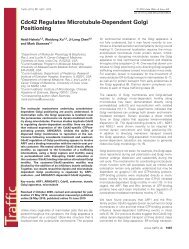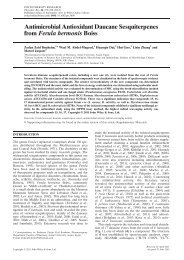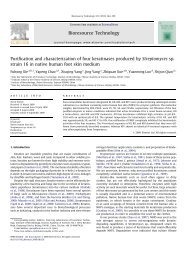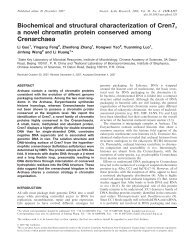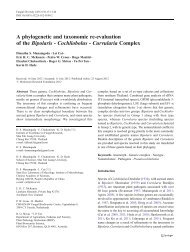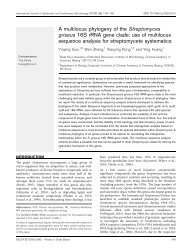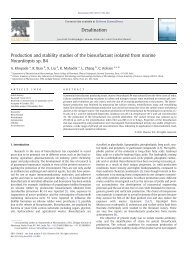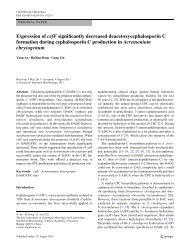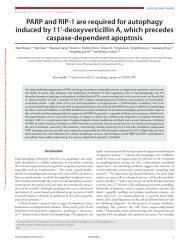Structure and Cleavage Specificity of the Chymotrypsin-Like Serine ...
Structure and Cleavage Specificity of the Chymotrypsin-Like Serine ...
Structure and Cleavage Specificity of the Chymotrypsin-Like Serine ...
You also want an ePaper? Increase the reach of your titles
YUMPU automatically turns print PDFs into web optimized ePapers that Google loves.
ARTICLE IN PRESS<br />
8 <strong>Structure</strong> <strong>and</strong> Characterization <strong>of</strong> PRRSV 3CLSP<br />
Fig. 5. Surface representation <strong>of</strong><br />
(a) <strong>the</strong> hydrophobic interface<br />
between domains II <strong>and</strong> III; (b)<br />
<strong>the</strong> exposed hydrophobic patch on<br />
one face <strong>of</strong> <strong>the</strong> C-terminal extra<br />
domain <strong>and</strong> (c) ano<strong>the</strong>r patch <strong>of</strong><br />
exposed hydrophobic residues<br />
located on a different face <strong>of</strong> <strong>the</strong><br />
same extra domain <strong>of</strong> both PRRSV<br />
(left) <strong>and</strong> EAV (right) nsp4s. Residues<br />
involved are labeled <strong>and</strong><br />
colored magenta. The surface is<br />
shown in cyan for PRRSV nsp4<br />
<strong>and</strong> in yellow for EAV nsp4.<br />
nsp4 is proteolytically active in vitro. In our assay,<br />
we showed that peptides corresponding to two<br />
junction sites can be cleaved by <strong>the</strong> enzyme. For<br />
each predicted cleavage site, <strong>the</strong> scissile peptide<br />
bond was between Glu <strong>and</strong> Gly.<br />
Just like o<strong>the</strong>r reports on peptide-based cleavage<br />
assays, 21,22 our enzyme also shows a remarkable<br />
difference in efficiency towards different peptides.<br />
Of <strong>the</strong> nine potential substrates investigated, only<br />
three can be cleaved to <strong>the</strong> extent <strong>of</strong> being detectable<br />
on an HPLC system (see Table 2). Peptide SP8-1,<br />
derived from <strong>the</strong> junction sequence between nsp11<br />
<strong>and</strong> 12, is most susceptible to this enzyme. After<br />
incubation with <strong>the</strong> recombinant enzyme, two new<br />
peaks with retention times <strong>of</strong> 16.9 <strong>and</strong> 17.4 min,<br />
respectively, were observed after analyzing a reaction<br />
volume <strong>of</strong> 40 μl on a C18 column (Fig. 6b). The<br />
uncleaved peptide gave a peak at 18.5 min, consistent<br />
with that for <strong>the</strong> peptide-alone control (Fig.<br />
6a). The two product peaks were collected <strong>and</strong><br />
analyzed by mass spectrometry (MS). The results<br />
showed that <strong>the</strong> calculated molecular masses corresponding<br />
to <strong>the</strong> peaks were 1241.6293 <strong>and</strong> 802.3875,<br />
respectively, matching <strong>the</strong>ir <strong>the</strong>oretical monoisotopic<br />
molecular weight (MW) perfectly (<strong>the</strong> <strong>the</strong>oretical<br />
MW for fragment KDKTAYFQLE is 1241.6291, <strong>and</strong><br />
for GRHFTW, it is 802.3874). A typical representation<br />
<strong>of</strong> <strong>the</strong> MS result is shown in Fig. 6f. When <strong>the</strong><br />
catalytic serine residue was replaced by alanine<br />
(Ser118Ala mutant), no detectable peaks <strong>of</strong> cleaved<br />
peptides were observed in <strong>the</strong> HPLC pr<strong>of</strong>ile (Fig.<br />
6c). This confirmed <strong>the</strong> crucial function <strong>of</strong> Ser118 as<br />
<strong>the</strong> nucleophile in catalysis.<br />
Ano<strong>the</strong>r peptide that was shown to be processed<br />
is SP1, which corresponds to <strong>the</strong> nsp3/nsp4 junction.<br />
However, <strong>the</strong> proteolytic efficiency for SP1 was<br />
much lower than that for SP8-1. Only a small portion<br />
(b20%) <strong>of</strong> <strong>the</strong> peptide was cleaved after a 15-h<br />
incubation (data not shown).<br />
The kinetic parameters <strong>of</strong> <strong>the</strong> protein were<br />
determined in vitro using a fluorescent assay system<br />
to quantitatively test <strong>the</strong> proteolytic activity <strong>of</strong> <strong>the</strong><br />
recombinant enzyme. The results showed that <strong>the</strong><br />
enzyme exhibits a K m <strong>of</strong> about 2.24 mM <strong>and</strong> a k cat <strong>of</strong><br />
about 0.435 min − 1 for <strong>the</strong> substrate Dabsyl-<br />
KTAYFQLE↓GRHFE-Edans.<br />
Please cite this article as: Tian, X., et al., <strong>Structure</strong> <strong>and</strong> <strong>Cleavage</strong> <strong>Specificity</strong> <strong>of</strong> <strong>the</strong> <strong>Chymotrypsin</strong>-<strong>Like</strong> <strong>Serine</strong> Protease (3CLSP/nsp4)<br />
<strong>of</strong> Porcine Reproductive <strong>and</strong> Respiratory Syndrome Virus (PRRSV), J. Mol. Biol. (2009), doi:10.1016/j.jmb.2009.07.062





